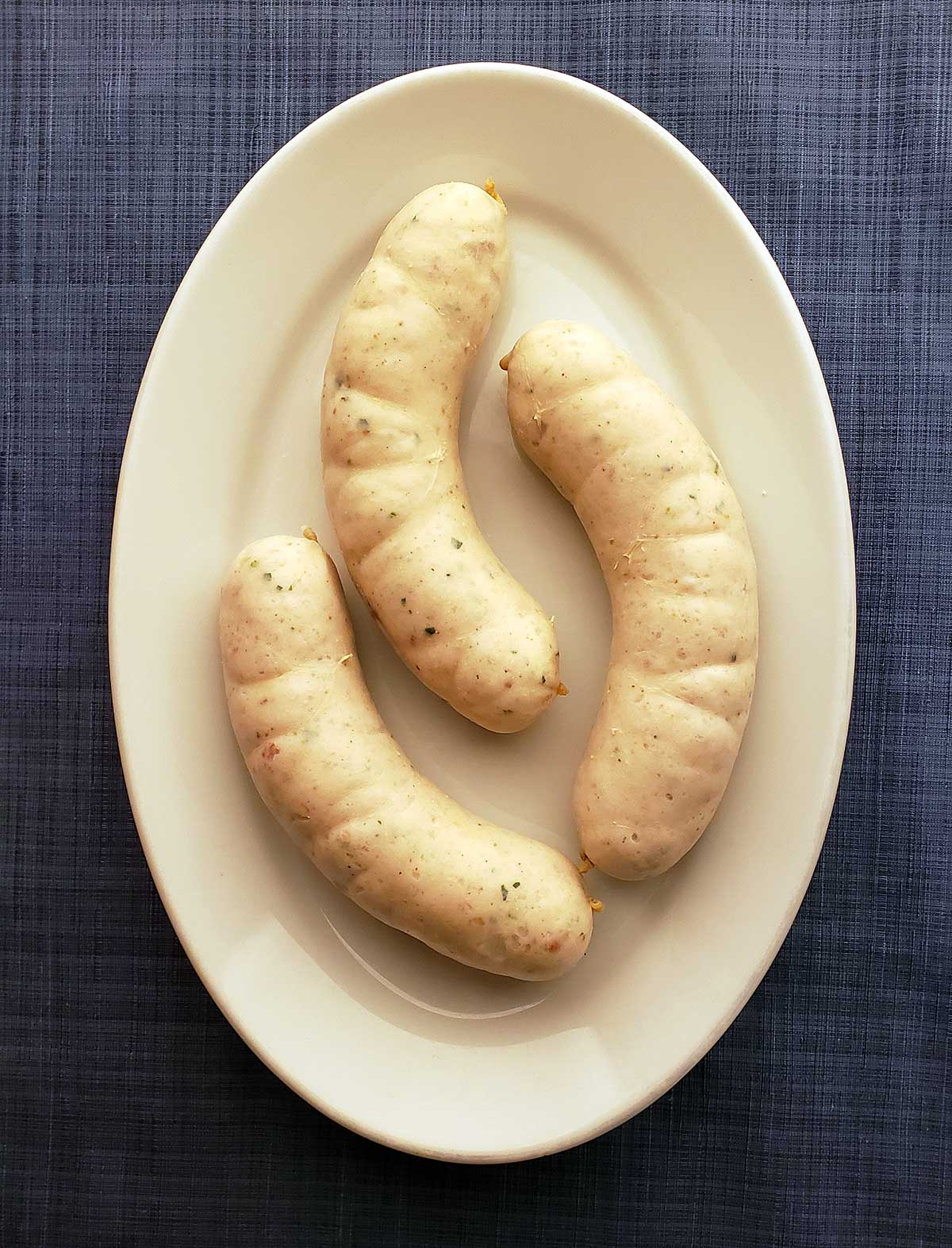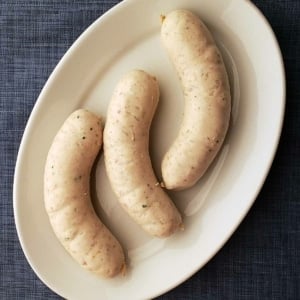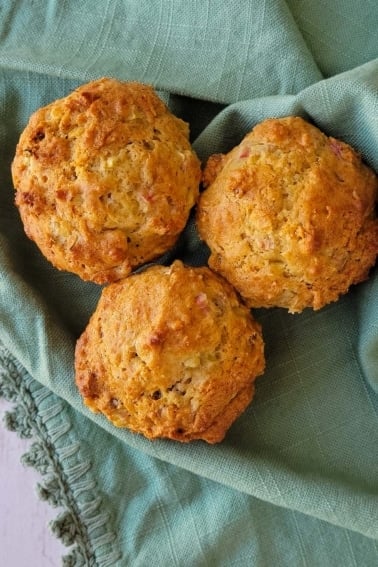As an Amazon Associate I earn from qualifying purchases.
As you may know, the Germans make some of the finest sausages in the world, and weisswurst is one of their best. Here’s how to make it at home.
Weisswurst means “white sausage,” and as you can see, it is. Traditionally, you make it with pork and/or veal. I like to mix pork and wild turkey or pheasant, but any combination works so long as there is enough fat in the mix.

And while they might look like the epitome of bland, weisswurst is actually a well-flavored link. Hidden in there are warming spices like mace and cardamom, as well as parsley and lemon zest. Think of weisswurst as the “deep ocean” of sausages — there’s a lot going on underneath that you just can’t see.
Bavaria is the spiritual home of Weißwurst, as they spell it in full-on German. And there this sausage is eaten rather oddly: You either suck the meat out of the casing, a little like some people do with Cajun boudin, or you slice the link lengthwise and eat the meat out of the casing. I find this weird, and just eat the casing, too. There’s nothing wrong with it, after all.
You should also know that real weisswurst sausage aficionados only eat them poached, so they stay pearly white. I like them this way, but don’t love them. I do love weisswurst poached to cook them, then seared or grilled a bit, more like a traditional Sheboygan bratwurst. Yes, I know this isn’t normal for this sausage. Sue me.
Not only are the eating methods unusual for weisswurst, the timing is, too. Historically, this must be some strange, crack-of-dawn task some poor wurstmeister had to do, because in Bavaria, Weißwurst is a breakfast sausage normally made fresh each day. Considering that this is at least an hour-long task even for small batches and skilled artisans, and really longer than that for most people, that’s some serious dedication.
I do like the traditional accompaniments to weisswurst, though: a big, soft, chewy pretzel and honey mustard. That’s good no matter how you cook them.
A few notes on making homemade weisswurst sausage.
- The grind is fine. Very fine, even. I grind meat at least twice, starting with a medium die and ratcheting it down to either 4.5 mm or even 3 mm, if I am feeling fancy. A 3 mm die will give you a grind very close to a hot dog.
- Veal and pork is the traditional mix, but I either make them all pork or sub in the poultry for the veal. Rabbit, turkey (wild or farmed), pheasant or chicken is what I am thinking of here. Unlike German bockwurst, which can be a little grayish from darker meats, weisswurst needs to stay white. So choose your meats accordingly.
- I really like adding C-Bind carrot fiber to this sausage to retain moisture. This keeps the sausages snappy and juicy. You can also use dry milk, or skip it.
- Unless you are going to eat your weisswurst the Bavarian way, i.e., not eating the casings, you do want regular hog casings at the very least, and narrow casings if you can find them. Really wide casings will be too tough for this sausage, which is fairly soft.
Finally, when you poach your homemade weisswurst sausage, do not let the water boil. In fact, it should not be even simmering. Just steamy, like about 160°F. Let the links swim in this hot bath about 20 minutes, and you are good to go.
They will keep in the fridge a few days, and freeze well.
Looking for more German sausage recipes? In addition to bockwurst and bratwurst, I have a braunschweiger recipe, too.
New to making sausage? You can find my detailed tutorial on how to make sausages at home here.
Homemade Weisswurst Sausage
Ingredients
- 1 tablespoon lard or vegetable oil
- 1/2 cup minced white onion
- 3 pounds white meat, pork, veal, turkey, rabbit, chicken
- 1 pound bacon ends or fatty pork shoulder
- 20 grams salt, about 2 tablespoons plus a teaspoon
- 1 tablespoon minced parsley
- 1/2 teaspoon dry mustard powder
- 1/2 teaspoon powdered ginger
- 1/2 teaspoon white pepper
- 1/2 teaspoon mace
- 1/2 teaspoon ground cardamom
- Grated zest of a lemon
- 1 teaspoon C-Bond carrot fiber (optional)
- 1 cup ice water
- Hog casings
Instructions
- Heat the lard in a small pan and cook the onions until soft. Do not brown them. Let them cool to room temperature, or refrigerate them. This can be done up to a day in advance.
- Optional Step: Cut the meat and bacon ends into chunks and mix with the salt. Refrigerate overnight in a closed container. Doing this helps the bind, but is not 100% needed.
- Soak about 10 feet of hog casings in warm water.
- When you are ready to grind, mix the meats, salt, parsley, spices and lemon zest. Grind through a coarse or medium die. Put the mixture in the freezer while you clean up, or, if the meat is still below 40°F, grind again through a fine die, at least 4.5 mm and ideally 3 mm. This time, definitely put the meat in the freezer while you clean up.
- Once the meat is at about 34°F, put it in a large bowl with the water and C-Bind, if you are using it. Mix this with your clean hands for about 90 seconds, or until the mixture binds together as a cohesive mass that you can pick up in one glob. Your hands should hurt from the cold.
- Put a length of casing on your sausage stuffer and fill it with the weisswurst. Crank out one large length of sausage, leaving about 3 to 5 inches of "tail," unfilled casing, on either end. You don't want to fill the casings overly tight just yet. Repeat this process until you have all the sausage in casings.
- Get a large pot of water hot, about 160°F.
- To form links, pinch off a link of about 6 inches long at one end of the length. Spin it away from you to set the link. Now move down the length and pinch off another link, but this time spin it towards you. Keep doing this, spinning in alternate directions, until you get to the end of the length. Doing this helps prevents the links from coming apart. (This video shows how I do it.) Tie off the ends.
- Now, to tighten them, get a clean needle or sausage pricker. Gently compress the meat in each length, spinning it a little more in the direction you first spun. You will see air pockets. Prick the casing to remove them, again gently compressing the links to fill the casing. Do this for every link.
- Carefully lower the weisswurst into the hot water. They will want to unspin a bit so watch for that. Poach them gently for 20 minutes or so. While they are cooking, fill a large basin with ice water. Dunk the links in this ice water after they've cooked. Leave them there for 10 minutes. Pat them dry and you are ready to go. They will keep for about 5 days in the fridge, and can be frozen.
Notes
Nutrition
Nutrition information is automatically calculated, so should only be used as an approximation.






I used this recipe to make Weisswurst for a family German themed dinner, everyone liked it. I used fresh ground pork and mixed in a little bacon in the grinder
Hello Hank reading the recipe for weisswurst in reference to the lemon zest it states zest of one lemon no matter the amount sausage been made, I am doing about five pounds what measurement would you recommend.
thanks
Guill
Guill: In that case, I’d still use zest from 1 lemon, because the original recipe is for 4 pounds, which is close enough. But sausage is part art, part science. If you wanted to use the zest from 2 lemons, it would be OK.
All of your recipes are well thought out and reproducible. Thanks for the work you do to give the tools to make these wonderful recipes.
We tried this with pork and bacon and it turned out deliciously. Thank you!
Hello Hank ,Your Weisswurst recipe seems wonderful, my question is can I use instead of C bind non-fat dry milk powder and if so how much per pound?
Thanks
Guill
Guill: Yes, you can use that. I’d only use about an ounce or so for a 5-pound batch.
Just seeing this recipe (looks great BTW). If I was making them to freeze Hank, do you think I could go right to the vacuum seal bag and then into the freezer, or should I poach them first and then freeze. Hats off to you Hank!
JB: I would poach first, then freeze.
If poached then refrigerated or frozen what do you suggest for reheating them? Thanks!
Ted: I like to grill them, but in Germany they’d likely poach them again to get warm.
Frankfurt Doner in Ball Ground, GA sells the best weisswurst I have ever eaten in the USA.
Patak meats is also wonderful but they had a fire and aren’t open yet. I hope this recipe will make the grade.
dear hank
I grew up in an immigrant neighborhood in new york,mostly German,some Italian. I could walk to at least 20 German butcher shops who made their own sausages. Alas, only one is left in Ridgewood now. Their only retail outlet is on Long Island. This is the Forest Pork Store. The quality of their wurst is the absolute highest. I believe they ship any where.
Weiswurst and bockwurst from this store is still my favorite sausage.
For the “honey mustard” – seek out Handlmeier’s sweet mustard, which I’ve found at local European delis near San Jose. Brings fond memories of working outside Munich in the 90s, whenever I eat it.
I have not had these since the late 70’s when stationed in Germany. These were one of my favorites when on Volksmarches. They were usually grilled at the check points and served with a local beer. I hate to admit it, but I never have time to make sausages.
Hank,
This one sounds interesting. Your sausage recipes never disappoint. A question on the carrot fiber – is there ever a reason NOT to use it when making sausage? I bought some online but the seller’s site didn’t offer a ton of info about it. Thanks.
Beth: Yes, if you are drying the sausage, even a little. Definitely don’t use it in dry cured products, and don’t use it in those hybrids where you make and dry a couple days even. But other than that, nope.
We discovered these on a trip to Munich. Had no idea about the sucking or not eating the skin until months after the trip. Makes you wonder what our waitstaff thought when we ate them in their entirety. I agree though, better grilled. Makes for a killer brat substitute. Fortunately we have a Bavarian sausage maker near our home in Wisconsin so we can get them any time.
Thanks Hank. you are the Elvis of salsiccia,and only you could imitate mazzafegati salati wity 1/3 liver,sausage meat,lots of strong spices.I tryed many times,but never could I get close to the real thing.
I have a few different versions of this recipe and I have been wanting to try it. This recipe seems both authentic and doable. I have made your sausages before and I like them! I will try this one soon!
What a Great recipe! I am from München, the Weißwurst Capital. Did you know, that any upstanding restaurant or beer hall in Bavaria serves the Weißwurst hot in a bowl of the poaching water, to keep it hot, especially when eating outside? Btw, no need to add the word sausage after Weißwurst. Wurst = Sausage. Patak in Atlanta makes a really authentic Weißwurst. The DeKalb Farmer‘s Market carries it.
Hilde: Thanks, and I know about the adding “sausage” part. English speakers will want that. 😉
Dear Hank,
how lovely to see this German specialty on your site.
In regards to not eating it after 12.00 noon, it had to do with refrigeration. There was actually a law that did not allow the sausage to be sold or served after midday. This has now been changed because of the fact that you can nicely preserve these sausages, but most die hard fans still only eat them for breakfast or an early lunch.
It should be served with a sweet mustard, soft bavarian pretzels and weissbier (wheatbeer).
With kind regards from Germany,
Bettina
Bettina: Ah, good to know, thanks!